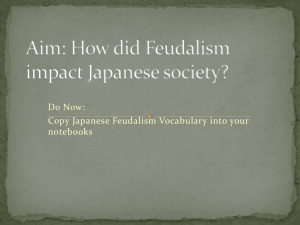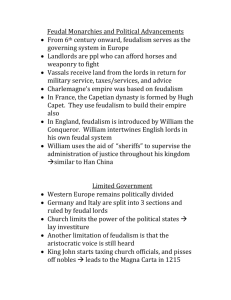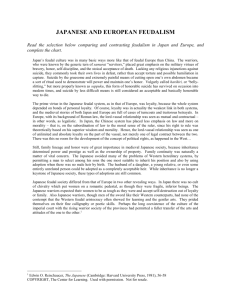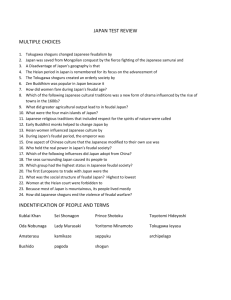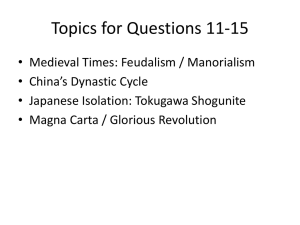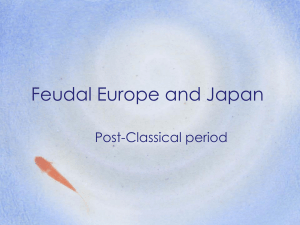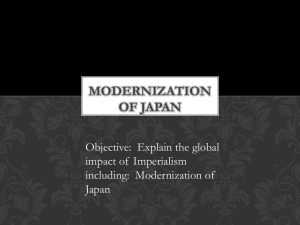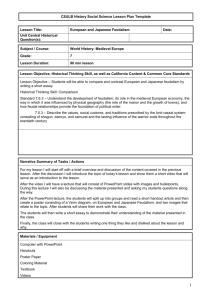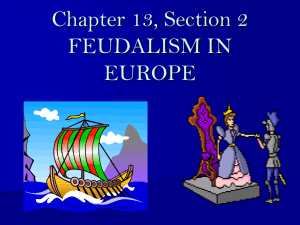FEUDAL JAPAN - Badantweb.com
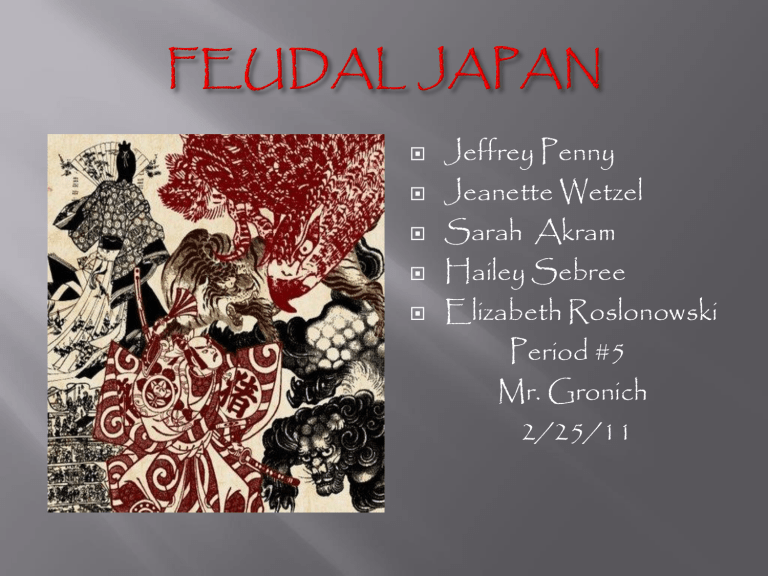
Jeffrey Penny
Jeanette Wetzel
Sarah Akram
Hailey Sebree
Elizabeth Roslonowski
Period #5
Mr. Gronich
2/25/11
Feudalism: is the social organization created by exchanging grants of land or fiefs in return for a formal oath for allegiance or promises of loyal service
The system of feudalism has been used not only in Japan but Germany, Western Europe and China
Feudalism usually results in weak government with highly powerful aristocratic lords or rulers.
Generally no central government
Fujiwara: highly powerful
Japanese aristocratic family in mid-9 th century
Bushi(Bushido) :feudal
Japanese warrior leaders who administered law; also the way of the warrior
Daimyo: loyal vassals
Samurai: mounted troops of
Japanese warrior leaders
Zen Buddhism(Chan
Buddhism): stressed the importance of meditation and the appreciation of natural and artistic beauty
Shinto: the way of the Gods
(Kami-no-michi)
Seppuku: ritual suicide or disembowelment in Japan
Shoguns: military leaders of the bakufu
Gempei wars: occurred for five years from 1180 on
Honshu between the Taira and Minamoto families(ended with the destruction of the Taira)
Japan like Korea and Vietnam borrowed and copied many characteristics and ideas from china and feudal china
Was born after the fall and decline of Imperial decline
Ultimately was about the dominant control of families and no strong government
Lasted from 1185 to 1333 C.E.
(approximately)
However, the emperor, courts and formal government was left intact, but as ceremonial figure heads
The bushi controlled many civil, military and judicial matters
The period was interrupted by the
Mongol invasions
Feudal Japan had much warfare
The civilization was highly militaristic
Military/loyalty values such as family alliances and ritualized combat blocked the growth of government(hence why aristocratic families became powerful)
Worst periods of internal conflict(civil wars) was in 17 th century
Once again, the feudalism system generated a weak central government
The political control rested in the hands of the
“Shogun” or military leaders
Had unsophisticated political systems
Regional leaders had armies of their own(loyalty)
Once again, rulers relied on loyalty and respect for power
“developed political values that embraced, most participants in the system”
Aristocratic lords controlled the mass of peasants
They practiced Zen Buddhism
Shinto and Japanese Buddhism was a single complex religion
Free religious freedom was granted
Participated in rituals and customs derived from religious traditions
Feudal Japan heavily borrowed ideas from
Chinese culture
The society was divided into various classes
Was ruled by the Shogun, who were military leaders with absolute control
Most successful was the “Tokugawa” shogunate(1603-1868)
They had steel manufacturing
Mastered bronze and metalworking
Silk paintings
Produced Japanese paper
Discoveries in astronomy
Kept their handicraft making secret
Developed textile technology
Had wooden architecture
Woodworking tools
The feudalism was highly based on military
Developed textile technology and wood working
Lawyers or Japanese legal system emerged
However, they were successful in industrial development
They also were adept in running Capitalist economies
Feudal Japan emerged after Imperial Japan fell
Emperor’s and the courts were used as ceremonial figure heads during this era
Aristocratic Lords especially the Fujiwara were very dominant and possessed military control
*Feudal System
Loyalty of the Japanese to their lords contributed to the success of this era.
A period of civil war or eternal conflict also erupted
